How to Make your own Tallow Sun Care Cream
When it comes to caring for our skin under the sun, nature often has the best answers. Over the years, I’ve found that simple, time-honored ingredients — like tallow — can offer deeply nourishing support for sun-kissed skin, made right at home! You’ll love this homemade tallow sunscreen and if you don’t have tallow on hand, I’ve got you covered!
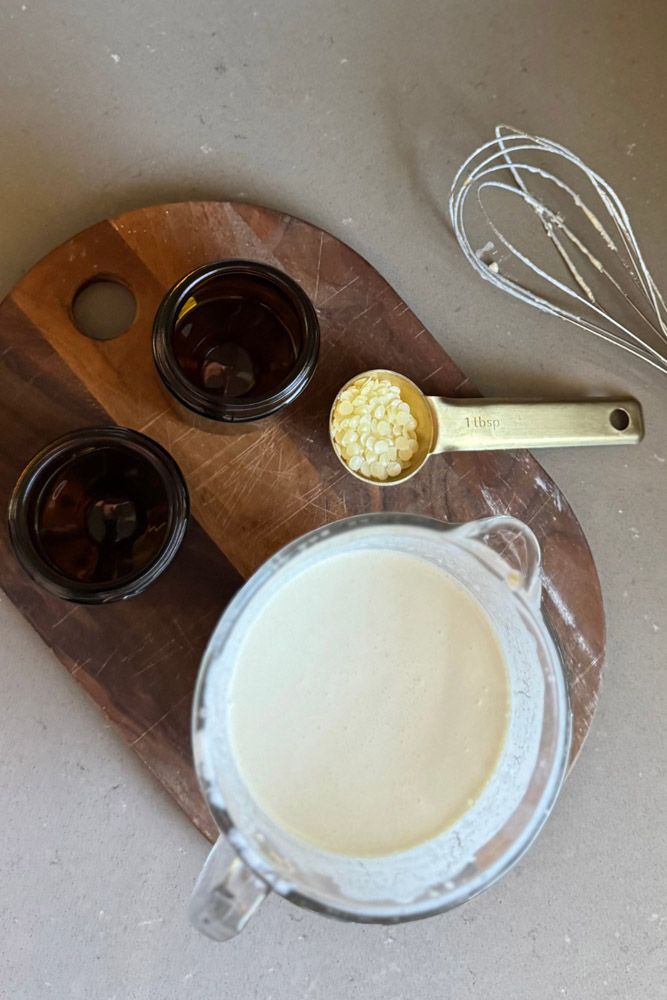
I’ve always been rather ‘solar-powered’. Once the temps stay around 60-70F degrees, you can find me outside, running from project to project, with my face toward the sun in gratitude! I can hardly wait for the sun to power me back up for the season.
The kids have their annual track meet on Friday and that reminds me that it’s time to make our annual batch of sunscreen. If it can pass the ‘no-sun-burn’ test on kids who are outside all day long, it’s a recipe worth repeating! I also love this recipe’s waterproof qualities as I work up a sweat in the garden. I like making a peppermint version that I keep in the fridge. It feels so cool and refreshing on hot summer days.
- Tallow Sunscreen Recipe
- Natural Sunscreen Recipe (without tallow)
- What is Non-Nano Zinc Oxide and Why Add it?
- What is the UV protection in these homemade recipes?
- FAQ’s
- What else can I make with the same ingredients?
- Sunscreen Label
- Shop this post
Why Choose a Natural Sun Care Cream?
This isn’t just any sun care recipe—this one’s rooted in old-world wisdom, made with farm-raised goodness and time-tested ingredients that deeply nourish and protect the skin.
- Tallow is the star here. Rich in fat-soluble vitamins A, D, E, and K, it closely mimics the structure of our own skin oils. That means it absorbs beautifully and supports skin repair, moisture balance, and barrier protection—especially after a day in the sun.
- Beeswax gives the cream staying power. It creates a breathable barrier that locks in hydration and helps the cream stay on during warm weather or light water play.
- Cocoa butter is ultra-nourishing and helps give the balm its luxurious feel, packed with antioxidants that support sun-exposed skin.
- Jojoba oil balances the blend by mimicking our skin’s natural sebum, keeping things light and hydrating without feeling greasy.
- Raspberry seed oil (optional) is loved for its antioxidant profile and is often praised for offering some natural sun-shielding properties.
- Carrot Seed Oil (optional) adds gentle regenerative support, especially helpful for maturing or sun-stressed skin.
- Lavender Essential Oil (optional) gives a soft calming scent and can soothe minor sun irritation.
- Non-nano zinc oxide (optional) is a reef-safe mineral that acts as a physical sunblock by reflecting UV rays off the skin—no absorption, just protection.
Listen, I’m not here to tell you to toss every other sunscreen bottle you own into the trash and go live barefoot in the woods (unless you want to — in which case, we should probably work on some natural bug repellent next). If I can make it at home, I’d at least like to give it a try, and this sun care cream really works! It’s just about giving your skin something it already understands — simple, natural nourishment.

Tallow Sun Care Cream Recipe
Makes approx. 26-28 oz
Ingredients:
- 1 cup tallow (rendered and strained)
- 1/2 cup jojoba oil (or avocado, almond, or olive oil)
- 1/2 cup cocoa butter
- 1/2 cup beeswax pellets
- 1/2 cup coconut oil
- 1/2 cup non-nano zinc oxide (cosmetic grade, uncoated)
- Optional: 1 tsp raspberry seed oil + ½ tsp carrot seed oil
- 20–30 drops essential oils (optional – try lavender, frankincense, or chamomile or my favorite- peppermint (just don’t use this one around the eyes)
Directions:
- In a double boiler or heat-safe glass bowl over simmering water, gently melt the tallow, cocoa butter, beeswax, coconut oil, and jojoba oil together. Stir occasionally until fully liquid.
- Remove from heat and let cool for about 5–10 minutes—just until it’s warm but no longer hot.
- Slowly whisk in the non-nano zinc oxide, being careful not to breathe in the powder. Stir until smooth and well combined.
- Add essential oils if using, and stir again.
- Pour into a wide-mouth pint mason jar, or divide into smaller containers or tins. We keep large jar in the fridge and a couple more jars for on the go.
- Let cool at room temperature until solid. Store in a cool, dark place. I like to keep ours it the refrigerator.
P.S. Don’t stress about perfection here. Your tallow cream doesn’t need to win a photo contest. As long as it’s smooth and dreamy on your skin, you’ve nailed it.)
How to Use
- Apply a small amount to exposed skin before moderate sun exposure.
- Reapply as needed, especially after swimming or sweating.
- Pair with good sun habits: hats, shade, breathable fabrics.
Note: This cream isn’t an FDA-tested sunscreen. It’s designed to support skin health during everyday living — gardening, walking, enjoying slow, outdoor moments.
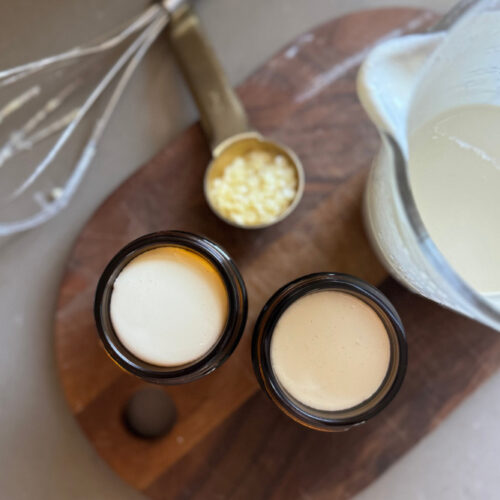
How to make Tallow Sun Care Cream
Ingredients
- 1 cup Tallow (rendered)
- 1/2 cup Jojoba Oil
- 1/2 cup Coconut Oil
- 1/2 cup Cocoa Butter
- 1/2 cup Beeswax Pellets
- 1/2 cup Non-Nano Zinc Oxide Powder (optional)
- 10-20 drops Essential oils (optional)
- 1 tsp raspberry seed oil + carrot seed oil (optional)
Instructions
How to make
- In a double boiler or heat-safe glass bowl over simmering water, gently melt the tallow, cocoa butter, beeswax, coconut oil, and jojoba oil together.
- Stir occasionally until fully liquid. Remove from heat and let cool for about 5–10 minutes—just until it’s warm but no longer hot.
- Slowly whisk in the non-nano zinc oxide, being careful not to breathe in the powder.
- Stir until smooth and well combined.
- Add essential oils if using, and stir again.
- Pour into a wide-mouth pint mason jar, or divide into smaller containers or tins. We keep large jar in the fridge and a couple more jars for on the go.
- Let cool at room temperature until solid.
- Store in a cool, dark place. I like to keep ours it the refrigerator.
How to use
- Apply a small amount to exposed skin before moderate sun exposure.
- Reapply as needed, especially after swimming or sweating.
- Pair with good sun habits: hats, shade, breathable fabrics.
Don’t have access to Tallow? Try this Natural Sunscreen Recipe:
Tallow-Free Sun Care Balm (Approx. 12–14 oz)
Ingredients:
- ½ cup shea butter
- ½ cup cocoa butter
- ¼ cup coconut oil
- ¼ cup jojoba oil (or almond/olive oil)
- ¼ cup beeswax pellets
- ¼ cup non-nano zinc oxide (1.3 oz)
- Optional: 15–20 drops of essential oils
- Optional: 1 tsp raspberry seed oil + carrot seed oil
Directions:
- In a double boiler or heat-safe glass bowl over simmering water, gently melt the shea butter, cocoa butter, coconut oil, jojoba oil, and beeswax together
- Remove from heat and let cool for about 5–10 minutes—just until it’s warm but no longer hot.
- Slowly whisk in the non-nano zinc oxide, being careful not to breathe in the powder. Stir until smooth and well combined.
- Add essential oils if using, and stir again
- Pour into a wide-mouth pint mason jar, or divide into smaller containers or tins. We keep large jar in the fridge and a couple more jars for on the go.
- Let cool at room temperature until solid. Store in a cool, dark place. I like to keep ours it the refrigerator.
Natural Sunscreen Recipe
Ingredients
- 1/2 cup shea butter
- 1/2 cup cocoa butter
- 1/4 cup coconut oil
- 1/4 cup jojoba oil (or almond/olive oil)
- 1/4 cup beeswax pellets
- 1/4 cup non-nano zinc oxide (1/3 oz)
- 15 – 20 drops essential oils optional
- 1 tsp raspberry seed oil optional
- 1 tsp carrot seed oil optional
Instructions
How to make
- In a double boiler or heat-safe glass bowl over simmering water, gently melt the shea butter, cocoa butter, coconut oil, jojoba oil, and beeswax together
- Remove from heat and let cool for about 5–10 minutes—just until it’s warm but no longer hot.
- Slowly whisk in the non-nano zinc oxide, being careful not to breathe in the powder. Stir until smooth and well combined.
- Add essential oils if using, and stir again
- Pour into a wide-mouth pint mason jar, or divide into smaller containers or tins. We keep large jar in the fridge and a couple more jars for on the go.
- Let cool at room temperature until solid.
- Store in a cool, dark place. I like to keep ours it the refrigerator.
How to use
- Apply a small amount to exposed skin before moderate sun exposure.
- Reapply as needed, especially after swimming or sweating.
- Pair with good sun habits: hats, shade, breathable fabrics.
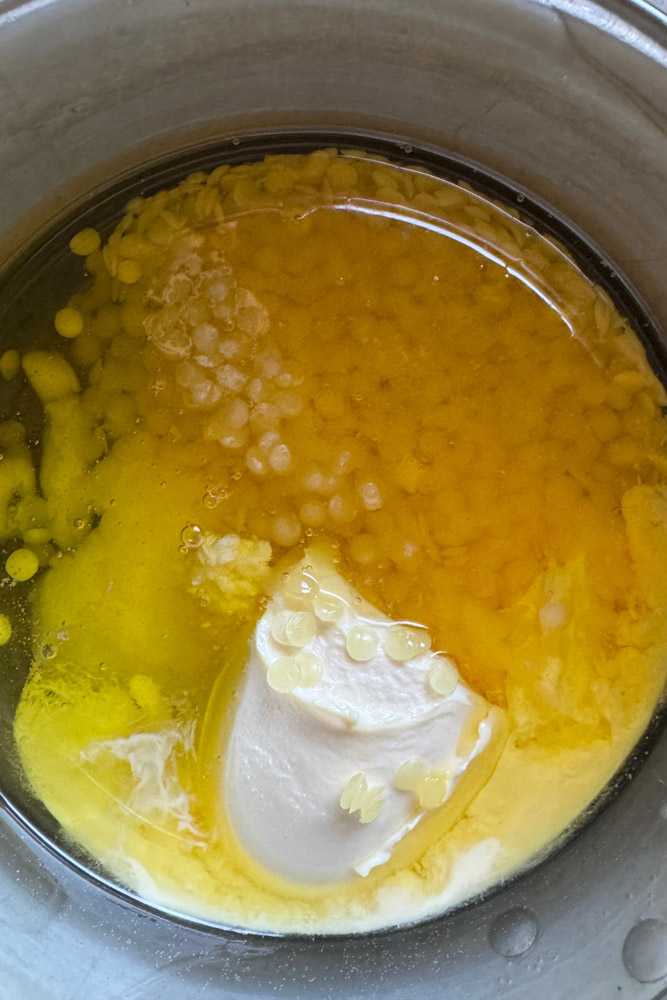
What is Non-Nano Zinc Oxide and Why Add it?
What Non-Nano Zinc Oxide Does for the Skin:
- Provides physical sun protection: Non-nano zinc oxide sits on top of the skin and reflects or scatters UV rays (both UVA and UVB). It doesn’t absorb into your bloodstream like some sunscreens.
- Gentle on sensitive skin: It’s often used in diaper creams and sensitive-skin products because it’s non-irritating and calming.
- Helps protect against sunburn: By forming a physical barrier, it can reduce the risk of sunburn when you’re outside.
- Offers mild soothing benefits: Zinc oxide can also feel calming if your skin is easily irritated by heat, sun, or sweat.
Why “Non-Nano” Matters:
It also means it leaves a slight white cast on the skin (more obvious if you use a lot), but that’s a natural trade-off for real, physical protection.
“Non-nano” means the zinc oxide particles are too large to penetrate the skin.
This is a good thing — you want it to stay on the surface to block the sun, not get absorbed into your body. It’s also environmentally friendly! Just like how it doesn’t absorb into your skin, the particles won’t be ingested by any wildlife after swimming in the lake (like us here in Minnesota) or the ocean!
What is the UV Protection of this Homemade Sunscreen?
Because this is a homemade formulation, it hasn’t been lab-tested—so it’s impossible to give it an exact SPF. That said, we can get a good ballpark idea based on the non-nano zinc oxide, which is the key UV-blocking ingredient here.
Non-nano zinc oxide provides broad-spectrum protection, meaning it helps guard your skin against both UVA and UVB rays. In most formulations:
- 20% zinc oxide typically yields an SPF 20–25
- Our recipe falls in that same general range, so while we can’t claim a verified SPF, it’s safe to assume it’s mild to moderate sun protection


Questions about Natural Sunscreen
Is this an SPF-rated product?
No. This is a nourishing sun care cream, not an SPF-tested sunscreen.
Will this block all sun exposure?
No — and that’s part of the beauty. This cream helps support your skin’s natural strength while still allowing you to embrace sunlight responsibly.
Is zinc oxide necessary?
Not at all. The cream is beautifully effective without it. Think of zinc as an extra tool you can choose to include if you wish.
Can I use this on my kids?
Yes, though it’s always best to patch test first, especially when using essential oils.
What Else Can I Make with These Same Ingredients?
When a natural product like tallow works so well, we milk it for all it’s worth. Tallow can be rendered to provide moisture and antioxidants to your lips, skin, and face. Tallow & Honey Body Wash and Tallow Moisturizer are some other tallow products we have hanging around our house (and our store ;)). Answers to more of your questions about this beneficial skincare product can be found here.
I have also gotten in the habit of adding in essential oils whenever and wherever I can – for the calming scents and the healing properties. Natural Deodorant was our other most recent addition on my journey toward making products that feel good to use, that I can make myself, and that I’d trust enough to hand to my kids. I have also crafted up 6 essential oil blends to enhance your home and sauna practices!
Grab Our Free Suncare Label Here
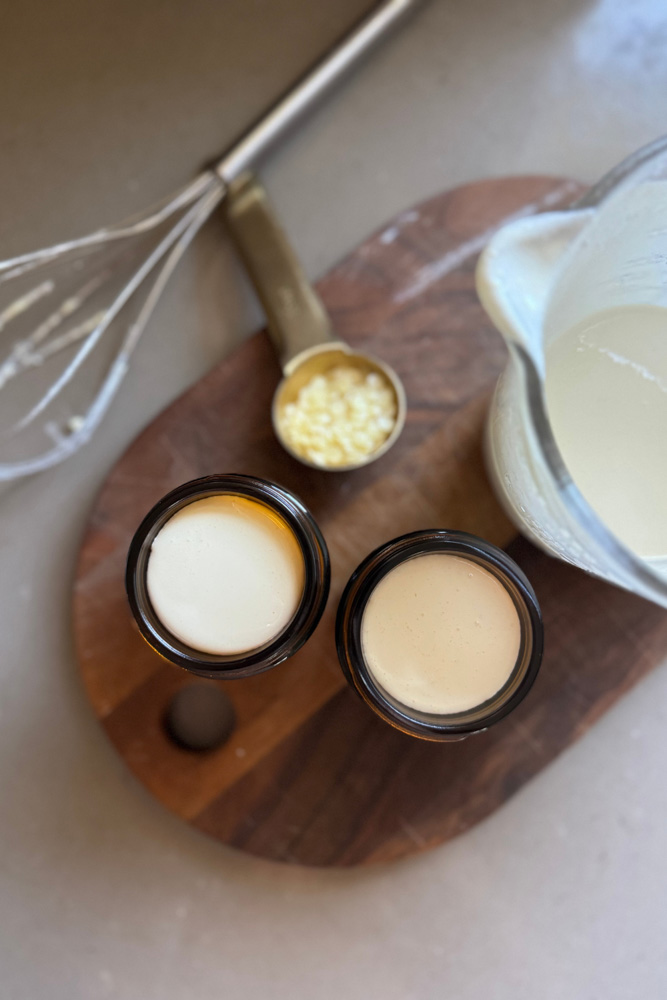
Shop this Post
These natural ingredients are also incredibly easy to find! As the warm months are upon us, I especially recommend checking out your local farmers market or apothecary store – there is a good chance these friendly faces will be stocked with the beneficial ingredients you can use in this sunscreen and other natural wellness products like our hair and scalp tonic. Tallow comes from the harvesting of our beef cows, but simply swing in to your local butcher to ask for some.
Pin for Later!
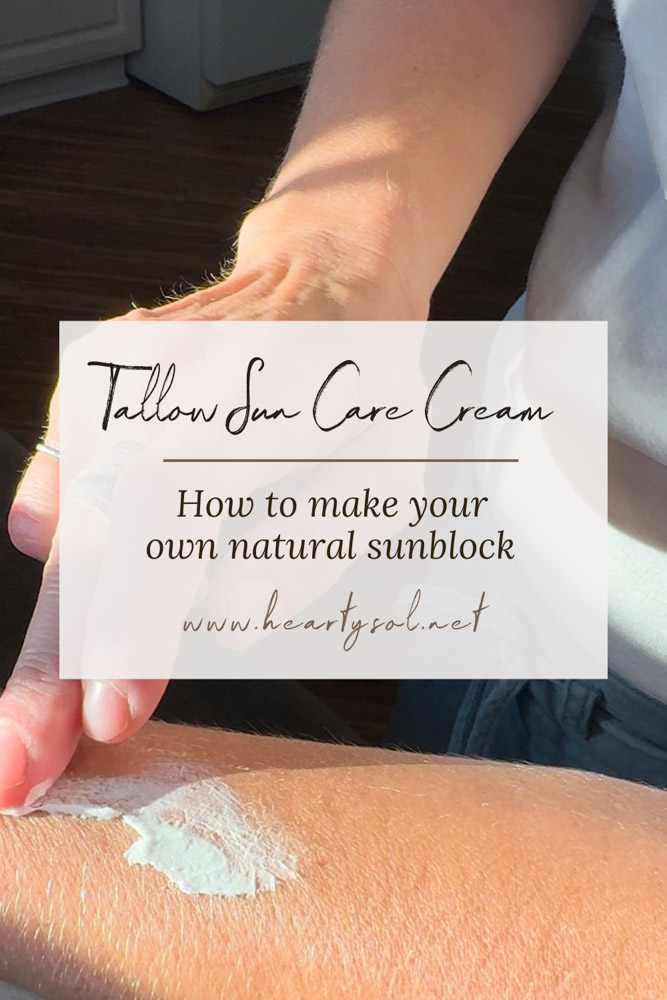

Affiliate Disclosure & Content Disclaimer
This post may contain affiliate links from a paid sponsor, Amazon or other program. When you use these links to make a purchase I earn a small commission at no extra cost to you. This allows me to continue creating the content that you love. The content in this article is created for information only and based on my research and/or opinion.
Emily T.
DAILY INSPIRATION ON THE GRAM @hearty.sol
it's hip to be square!
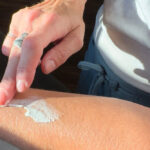
View comments
+ Leave a comment